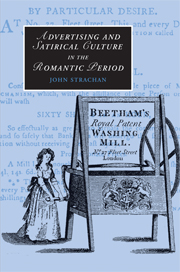Book contents
- Frontmatter
- Contents
- List of illustrations
- Acknowledgements
- Introduction
- 1 A ‘department of literature’: Advertising in the Romantic period
- 2 ‘Humbug and Co.’: Satirical engagements with advertising 1770–1840
- 3 ‘We keeps a poet’: Shoe blacking and the commercial aesthetic
- 4 ‘Publicity to a lottery is certainly necessary’: Thomas Bish and the culture of gambling
- 5 ‘Barber or perfumer’: Incomparable oils and crinicultural satire
- 6 ‘The poetry of hair-cutting’: J. R. D. Huggins, the emperor of barbers
- Conclusion: ‘Thoughts on puffs, patrons and other matters’: Commodifying the book
- Notes
- Bibliography
- Index
- CAMBRIDGE STUDIES IN ROMANTICISM
Introduction
Published online by Cambridge University Press: 22 September 2009
- Frontmatter
- Contents
- List of illustrations
- Acknowledgements
- Introduction
- 1 A ‘department of literature’: Advertising in the Romantic period
- 2 ‘Humbug and Co.’: Satirical engagements with advertising 1770–1840
- 3 ‘We keeps a poet’: Shoe blacking and the commercial aesthetic
- 4 ‘Publicity to a lottery is certainly necessary’: Thomas Bish and the culture of gambling
- 5 ‘Barber or perfumer’: Incomparable oils and crinicultural satire
- 6 ‘The poetry of hair-cutting’: J. R. D. Huggins, the emperor of barbers
- Conclusion: ‘Thoughts on puffs, patrons and other matters’: Commodifying the book
- Notes
- Bibliography
- Index
- CAMBRIDGE STUDIES IN ROMANTICISM
Summary
The ‘constant reader’ of the newspaper always reads, or at least glances at the advertisements. Those who merely take up the broad sheet to glean the passing news of the day, might think time so employed wasted or ill-bestowed; but the experienced and leisurely newspaper reader knows better. He has discovered that the department mentioned contains bits of news, and information, and amusement, very varied, often very curious and useful, and such as are to be obtained through almost no other channel. He has learned gradually to find in it something more: something to open his mind, to excite his imagination, to soften his heart. In the case of a metropolitan print, it appears to him to be an epitome of London, just as London is an epitome of the world; and his soul expands as he sees within its grasp, in one sweep, as it were, of his mental vision, the joys, the sorrows, the recreations, the sufferings, the longings, and attainments of society – in short, the whole social microcosm.
Chambers' Edinburgh Journal (1851)This book is the first within the field of Romantic studies to pay close and sustained attention to the discourse and cultural resonance of advertising copy, and the first full-length account of the importance of advertising to the satirical and parodic writing of the late Georgian period. I write this somewhat immodest sentence not in imitation of the self-promotional strategies of the advertisers discussed in this book, but, in part, to explain its genesis.
- Type
- Chapter
- Information
- Publisher: Cambridge University PressPrint publication year: 2007



